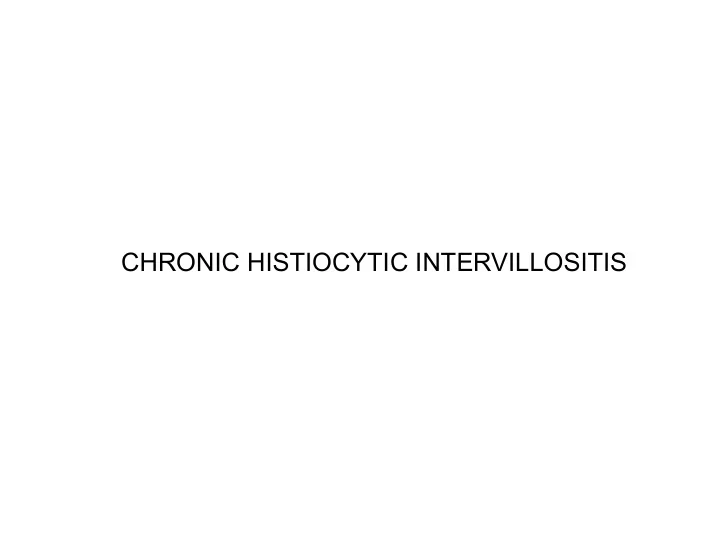

CHRONIC HISTIOCYTIC INTERVILLOSITIS
CD68
CD68
Chronic Histiocytic Intervillositis Background and Pathology: D efined by histologic findings of: - Diffuse infiltration of intervillous space by a monomorphic population of CD68 positive histiocytes. - Increased perivillous fibrinoid and EVT. - Grossly the placenta is usually small. Incidence: Second/third trimester (0.6 in 1000) First trimester (10/1000) Abortions with normal karyotype (22/1000) Women with recurrent spontaneous abortions (80/1000) Differential Diagnosis: 1) If villitis is present or polymorphous intervillous infiltrate CHI is excluded. 2) Malaria looks the same (40% can ID orgnanisms; 35% black pigment).
MALARIA INTERVILLOSITIS hfp://en.wikipedia.org/wiki/File:Maternal_malaria_placenta_-‑_cropped_-‑_very_high_mag.jpg ¡
MALARIA INTERVILLOSITIS hfp://en.wikipedia.org/wiki/File:Maternal_malaria_placenta_-‑_cropped_-‑_very_high_mag.jpg ¡
Chronic Histiocytic Intervillositis Clinical ¡associa*ons: ¡ Recurrent ¡spontaneous ¡abor1on, ¡ IUGR , ¡IUFD ¡(up ¡to ¡77%). ¡ ¡ ¡ Only ¡18% ¡make ¡it ¡to ¡third ¡trimester. ¡ If ¡survive ¡to ¡14 ¡weeks, ¡50% ¡are ¡liveborn. ¡ Recurrence ¡rate ¡very ¡high ¡(up ¡to ¡80%). ¡ ¡ E*ology: ¡ ¡ UNKNOWN. ¡ No ¡effec1ve ¡treatment. ¡ Immune ¡dysfunc1on. ¡ ¡ Associa1on ¡with ¡MPVFD/MFI? ¡ ¡ References: ¡ Boyd ¡TK ¡& ¡Redline ¡RW ¡ ¡Hum ¡Pathol ¡31:1389-‑1396, ¡2000. ¡ Parant ¡O ¡et ¡al. ¡ ¡Eur ¡J ¡Obstet ¡Gynecol ¡Repro ¡Biol ¡143:9-‑13, ¡2009. ¡ Contro ¡E ¡et ¡al. ¡Placenta ¡31:1106-‑1110, ¡2010. ¡ Marchaudon ¡V ¡et ¡al. ¡ ¡Placenta ¡32:140-‑145, ¡2011.* ¡ ¡ ¡ Have ¡seen ¡a ¡case ¡of ¡discordant ¡twins ¡(A ¡affected ¡and ¡B ¡unaffected). ¡ ¡
Proposed histologic grading system for chronic histiocytic intervillositis by Rota et al. (not routinely used, but does correlate with outcome): Grade 1: Inflammatory infiltrate (histiocytes) and fibrin occupy less than 10% of the intervillous space. Grade 2: 10-50% of the intervillous space is occupied by inflammatory cells and fibrin. Grade 3: greater than 50% of the intervillous space is affected.
SAMPLE NOTE: Note: Histologic examination of the placenta reveals diffuse intervillous histiocytes (CD68 positive) with a few associated neutrophils. There is no significant increase in perivillous fibrin. These findings are consistent with chronic histiocytic intervillositis (1- Contro E et al. Placenta 31:1106-1110, 2010; 2- Marchaudon V et al. Placenta 32:140-145, 2011; 3- Boyd TK and Redline RW. Human Pathol 31:1389-1396, 2000). The differential diagnosis of these findings includes infectious etiologies, especially malaria. No malaria organisms or pigment are noted in this case. The etiology leading to chronic histiocytic intervillositis remains unknown. Chronic histiocytic intervillositis is associated with a high recurrence rate (up to 70%) and is frequently associated with early pregnancy loss, IUGR, and stillbirth. This patient had a prior pregnancy loss (NMH#........), which is reviewed with this case and reveals insufficient villi for evaluation. There is concern for possible recurrence in future pregnancies.
CASE 23 27 yo G5P3 woman at 39 4/7 weeks gestation who presented with pre- eclampsia. Spontaneous rupture of membranes and a male fetus (weight 2310 gm) was delivered by NSVD with Apgars of 8 and 9. Additional history included prior persistent molar pregnancy in 2001 requiring 1 year of MTX therapy and a history of CIN2 with cryotherapy. Since 2004 her other three pregnancies were NSVD at 37, 34 and 39 weeks gestation and all AGA. The placenta in the current case was large for gestational age (weight 760 gm; expected at 39 w 426-611 gm) with an unremarkable 3 vessel umbilical cord and a small area of adherent marginal blood clot (occupying <5% of maternal surface).
MASSIVE PERIVILLOUS FIBRIN DEPOSITION/ MATERNAL FLOOR INFARCT
Placenta LGA 760 gm (expected 39 w 426-611 gm). 3 vessel UC
<5% adherent blood clot
Another case of MPVFD Placental weight: 221 g (175-280 g expected.)
Patient ’ s Placenta Normal Placenta Close up here
Summary ¡of ¡gross ¡features ¡ • Dense, ¡firm ¡placenta ¡with ¡a ¡thickening ¡of ¡the ¡basal ¡ plate ¡ ¡ • Diffusely ¡distributed ¡pafern ¡of ¡ver1cally ¡oriented ¡firm ¡ trabeculae ¡and ¡a ¡lance-‑like ¡deposi1on ¡of ¡fibrin ¡that ¡ involves ¡the ¡full ¡thickness ¡of ¡the ¡placenta. ¡ ¡ ¡ • Typically, ¡the ¡placenta ¡is ¡small ¡for ¡gesta1onal ¡age, ¡ however, ¡the ¡placenta ¡may ¡be ¡of ¡normal ¡or ¡even ¡ increased ¡weight ¡due ¡to ¡the ¡presence ¡of ¡abundant ¡ fibrin, ¡as ¡was ¡seen ¡in ¡the ¡case ¡presented. ¡ ¡
Increased perivillous fibrin
Increased perivillous fibrin with associated extravillous trophoblast cells.
Increased perivillous fibrin with entrapped avascular villi.
Increased intervillous histiocytes.
Recommend
More recommend